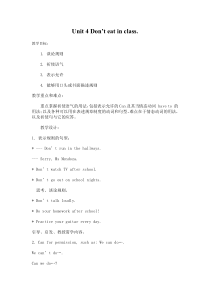 DOC
DOC
【文档说明】《Unit 4 Don’t eat in class》教学设计12-七年级下册新目标英语【人教版】.doc,共(4)页,19.000 KB,由小喜鸽上传
转载请保留链接:https://www.ichengzhen.cn/view-102967.html
以下为本文档部分文字说明:
Unit4Don’teatinclass.教学目标:1.谈论规则2.祈使语气3.表示允许4.能够用口头或书面描述规则教学重点和难点:重点掌握祈使语气的用法,包括表示允许的Can及其当情态动词haveto的用法;以及各种可以用在表述规章制度的动词和句型。难点在于情态动词的用法,以及祈使句与它的应答
。教学设计:1.表示规则的句型:*---Don’truninthehallways.---Sorry,MsMendoza.*Don’twatchTVafterschool.*Don’tgooutonschoolnights.思考、谈论规则。*Don’ttalkloudly.*D
oyourhomeworkafterschool!*Practiceyourguitareveryday.引导、启发、教授需学内容。2.Canforpermission,suchas:Wecando„.Wecan’tdo
„.Canwedo„?*---Whataretherules?---Well,wecan’tarrivelateforclass.*---Canwelistentomusic,Alex?---Wecan’tlistentomusicinthehallways,but
wecanlistentoitoutside.3.听录音,回答问题。*---Canweeatintheclassroom?---No,wecan’t.*---Canstudentswearhatsinscho
ol?---Yes,theycan.放录音;启发、提示问题及答语。4.阅读→迁移(读、写、文化差异)。阅读/认图标;阅读信件→根据其信息找出规则→写出规则。引导、提示图标含义;提示文化差异。5.用口头或书面形式描述规则。6.利用本单元所学祈使语气的
用法,包括表示允许的Can及其当情态动词用的havetodo,根据常识或观察,为图书馆、生化实验室、语音室、机房、健身房、游泳馆等公共场所制定规章制度或使用规则。7.检查学生讨论制定规章制度或使用规则情况——句型、短语、动词形式是否正确;指导并落实学生写作情况。教学过程设计:T
askOne:Talkaboutschoolrulesto“feel”ImperativesGoal:GettoknowaboutthestructuretoexpressrulesStep1:Talkabouttheschoolrulestheyk
now/rememberStep2:LookatthepictureandreadtherulesinSectionA–1a,tellingthedifferencebetweenyoursStep3:Addmorerulestoyour
school,whichyouthinknecessaryTaskTwo:ListenandfindoutwhatSscandoandwhattheycannotGoal:Trytounderstandthe
rulesbylisteningStep1:ListentoconversationsabouttheactivitiesandfindoutwhatstudentscandoandwhattheycannotdoStep2:Listentoconversationsabo
uttheactivitiesandfindoutwhatAlexandChristinacandoandwhattheycannotdo→SectionA(2a/b)Step3:Listentoconversationsabouttheactivitiesandfindout
whatrulesstudentsbreak→SectionA(1b)Step4:Listentothedifferentrulesthatdifferentpeoplehavetofollow→SectionB(2a/b)
TaskThree:LearntoreadthesignsforrulesGoal:LearnabouttherulesbyreadingthesignsStep1:Learnabouttherulesb
yreadingthepictures→SectionB1Step2:Learnabouttherulesbyreadingthesigns→SectionB(3b)Step3:Talkaboutthesimilaritiesorthedifferencesabout
thesignsbetweenChinaandabroadTaskFour:Writerulesforlibraries,labs,computer-rooms,andswimmingpoolsetc.Goal:Learntotakecareofpublict
hingsStep1:Readtheletter→SectionB(3a)FindtherulesintheletterWritethemdownStep2:Talkinpairsabouttherulesforpublicplaces,suchaslibraries,
labs,computer-rooms,swimmingpools,etc.DiscussingroupsabouttherulesforthesepublicplacesWritedownwhathavebeentalkedabout/discussed教学点评与反思
:设计思路:任务型课程的设计要自始至终体现任务的要求与特点,尤其要确保任务的设计与完成是从简单重复逐步过渡到真实或接近真实。基于这一要求与特点,本课的四个任务先以谈论有关学校各项规章制度为话题,初步感受祈使句,以及如何表达规则;然后听(通过听那些能做、哪些不能做的事儿,体会情态动词
can和can’t的用法)、认(通过认图标,说出规则,并把说出的规则写下来),最后根据常识或观察,为图书馆、生化实验室、语音室、机房、健身房、游泳馆等公共场所制定规章制度或使用规则。这样,通过完成这一系列任务,既使学生学会了如何描述规章制度,又渗透了对学生的情感教育:通过对公共场所制定规章
制度,培养学生遵守公德、爱护公物的美德。同时,学生还可以学会发散思维,以扩展知识;口头及书面表达能力也可随之提高。二、课后反思:不足之处:图标展示得不够;还可通过图标渗透中外文化差异。可取之处:全方位的训练了学生的听、说、读、写的能力。。
 辽公网安备 21102102000191号
辽公网安备 21102102000191号
 营业执照
营业执照